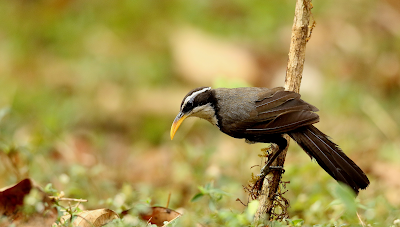One usually thinks that birding in the Himalayas involves long tiring treks over steep slopes and camping in the mountains, all while carrying luggage and your birding equipment. While birding in the northernmost reaches of the mountains may be so, birding in the Himalayan foothills is actually a leisurely experience, and relatively easy.
The wildlife and birdwatching destinations of North India are perfect for anyone who is a first-time visitor to the country and its wildlife. With a wide variety of landscapes and habitats, home to a wide variety of animals and birds, this region is one of the most promising and fulfilling of wild destinations that India has to offer. This guided birdwatching and wildlife tour takes you to some of the best sites of North India, such as Sultanpur National Park, the Doon Valley in the Garhwal Himalayas, Himalayan Foothills near Nainital, and the Corbett National Park, one of India’s premier tiger reserves.
Your first destination on this tour of the Himalayan foothills is the picturesque Doon Valley, home to the hill station of Dehradun, the capital of Uttarakhand. Nestled amidst the Himalayas and the Shivaliks, and Rivers Ganges and Yamuna, Dehradun is one of the most popular hill stations of the country. Apart from being home to many tourist attractions, the Doon Valley is also a great birding destination, acting as a gateway to the rest of the Garhwal region, with species like Grey-headed and Scaly-bellied Woodpeckers, Crimson Sunbird, Changeable Hawk-Eagle, Cinereous Vulture, and more.
The nearby forests of Jabarkhet and the surrounding areas have immense ecological value, both for the biodiversity they harbor and the services they provide. As one of the few remaining natural forest patches near Mussoorie with connections to the Shivalik Hills and the middle Himalayas, they form an important wildlife corridor. They also sustain a critical water source that feeds into the Kolti Nala, which is the source of water supply for a large section of Mussoorie residents.
From the Doon Valley in the Garhwal region, you head to the other part of Uttarakhand, known as Kumaon, and India’s oldest and possibly best-known tiger reserve, the Corbett National Park. Established as the Hailey National Park in 1936, Corbett is India’s oldest national park and tiger reserve. Located in the western Himalayan foothills, Corbett is one of India’s premier wildlife destinations. Apart from a healthy population of tigers and elephants, Corbett is also home to a wide variety of birds. The park is also home to a wide variety of habitats, from riverine belts, marshlands, and lakes, to forests and grasslands, adding to both its natural beauty and biodiversity.
Corbett is best explored by jeep or canter (open bus) safaris. One also has the option of staying inside the park at the forest rest house in Dhikala. However, the Dhikala Rest House is not luxurious, and only has a limited number of bookings available.
Moving up the Kumaoni foothills, you travel to the little hamlet of Pangot. Pangot is a quiet hamlet surrounded by the Himalayas, lush meadows, tall Deodar and Oak trees and is home to a variety of bird species. You will experience the true heritage of the ecovillage at a local family’s home, share a cup of tea with them, share their stories and experiences, experience the local cuisine and immerse yourself in the very aura of this quaint haven.
Governor’s House (Raj Bhawan) is another excellent site to learn more about the old world charm of Pangot and its surrounding areas. Spend time walking around the village, observing the way of life and understanding the heritage and cultural values of Pangot and its neighbours,
Nowadays, Pangot is first and foremost known as a birding paradise. The thick Deodar forests prove to be an ideal hangout hotspot for birds. One can see a variety of Himalayan species such as Himalayan Vulture, Blue-winged Minla, Spotted & Slaty-backed Forktail, Rufous-bellied Woodpecker, Rufous-bellied Niltava, Kalij Pheasant, a variety of thrushes, and more. Almost 150 bird species have been recorded at Pangot and the surrounding areas.
Apart from being India’s oldest birding lodge, Jungle Lore Birding Lodge in Pangot is also at the forefront of the Zero Waste Pangot project, a project that aims to reduce waste by adopting responsible waste and water management practices, and teaching them to other lodges in Pangot. Through village walks, Jungle Lore also showcases local rural village life, while activities like cooking classes help traditional practices endure and spread.
Nearby Pangot is another birding hotspot known as Sat Tal. Located in the Himalayan foothills near Nainital, Sat Tal is named after the seven interconnected lakes located near it. Set amongst dense forests of oak and pine trees, Sat Tal is one of the few unspoiled and unpolluted freshwater biomes in India. These lakes are a paradise for migratory birds. It is home to a few camps being operated mostly by local people catering to tourists looking for outdoor vacations.
Sat Tal is home to the Sattal Mission Estate and Methodist Ashram, better known as the Sattal Christian Ashram, which was established in the early 20th Century by a Christian evangelist and missionary. It is one of the heritage places in Sat Tal and provides an insight into the olden times. Another heritage site in Sat Tal is the beautiful waterfall, Subhash Dhara, which is a natural spring of crystal clear water that cascades down from the lush oak forest. The locals of Sat Tal prepare local traditional delicacies which form the heritage value of the town.
To know Information's
www.asianadventures.net
E: info@asianadventures.in
M: 08010450000





















